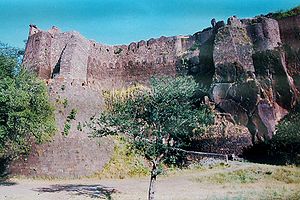- Asirgarh
-
Asirgarh Qila 
Asirgarh FortAsirgarh shown within IndiaCoordinates 21°28′N 76°17′E / 21.47°N 76.29°ECoordinates: 21°28′N 76°17′E / 21.47°N 76.29°E Built by Ahir, Hindus Construction
materialsStone, Lime-stone and Lead Current
conditiondilapidated Current
ownerGovt. of India Open to
the publicyes Occupants Ahirs, Bargujar, Mughal, Holkars, British Asirgarh Qila (Hindi: असीरगढ़ क़िला ;; آسیر گڑھ ) is an Indian fortress (qila) situated in the Satpura Range, about 20 km north of the town of Burhanpur, in Burhanpur District of Madhya Pradesh state. The fortress commands a pass through the Satpuras connecting the valleys of the Narmada and Tapti rivers, one of the most important routes from northern India to the Deccan in the southwest. It is known as the "key to the Deccan". This fort was built by Asa Ahir an Ahir king,[1] its original name being Asa Ahir Garh. By subsequent usage three middle letters were dropped.
History
The ancient inscriptions in the Pali Buddhist character have been discovered in various parts of Rajasthan of the race of Taxak or Tak, Taka, Dhaka relating to the tribe Mori and Parmara are their descendants. Taxak Mori was the lord of Chittor from very early period.[2][3]
The Huna Kingdom of Sialkot (of Mihir Kula 515–540 AD), destroyed by Yashodharman, was subsequently seized by a new dynasty of kshatriyas called Tak. The Taxak Mori as being lords of Chittor from very early period and few generations after the Guhilots supplanted the Moris, this palladium of Hindu liberty was assailed by the arms of Islam. (725-35) we find amongst the numerous defenders who appear to have considered the cause of Chittor their own the Tak from Asirgarh. This race appears to have retained possession of Asirgarh for at least two centuries after this event as its chieftain was one of the most conspicuous leaders in the array of Prithvi Raj. In the poems of Chandar he is called the "Standard, bearer, Tak of Asir." [4]
In 1536, the Mughal Emperor Humayun, after his conquest of Gujarat, had visited Burhanpur and Asirgarh, travelling via Baroda, Broach (Bharuch) and Surat. Raja Ali Khan (1576–1596), also known as Adil Shah, was asked to submit to Akbar, when the latter had sent an expedition to Khandesh, in the summer of 1577 A.D. The former, to avoid an unequal contest with Akbar, dropped his royal title of "Shah" and pledged suzerainty to Akbar. This was a significant achievement of the Mughals, for Khandesh was used as a base for the future conquest of the Deccan. Raja Ali Khan constructed many buildings: Jama Masjid in the upper portion of the fort of Asir in 1588, Jama Masjid at Burhanpur in 1590, Idgah at Asir, mausoleums and serai at Burhanpur, and serai and a mosque at Zainabad.
Bahadur Khan (1596–1600), successor of Raja Ali Khan, declared his independence and refused to pay homage to Akbar and his son Prince Daniyal, which enraged Akbar, who marched towards Burhanpur in 1599 and occupied the city on 8 April 1600 without opposition. Akbar visited Asirgarh to inspect it personally, staying for four days before returning to his headquarters at Burhanpur.
See also
References
- ^ The Maāthir-ul-umarā: being biographies of the Muḥammadan and Hindu officers. By Shāhnavāz Khān Awrangābādī, Baini Prashad, ʻAbd al-Ḥayy ibn Shāhnavāz, Page no.447 [1]
- ^ James Tod, Annals and Antiquities of Rajasthan, p. 126
- ^ Dr Naval Viyogi: Nagas – The Ancient Rulers of India, Their Origins and History (The History of the Indigenous people of India Vol. 2), Published by Originals (an imprint of Low Price Publications), Delhi, 2002, ISBN 81-7536-287-1, p.171
- ^ Dr Naval Viyogi: Nagas – The Ancient Rulers of India, Their Origins and History (The History of the Indigenous people of India Vol. 2), Published by Originals (an imprint of Low Price Publications), Delhi, 2002, ISBN 81-7536-287-1, p.148
Forts of Khandesh Asirgad · Bhamer · Laling · Parola · Thalner
Categories:- Forts in Madhya Pradesh
- Burhanpur district
- Mountain passes of India
- Former Indian capital cities
Wikimedia Foundation. 2010.

